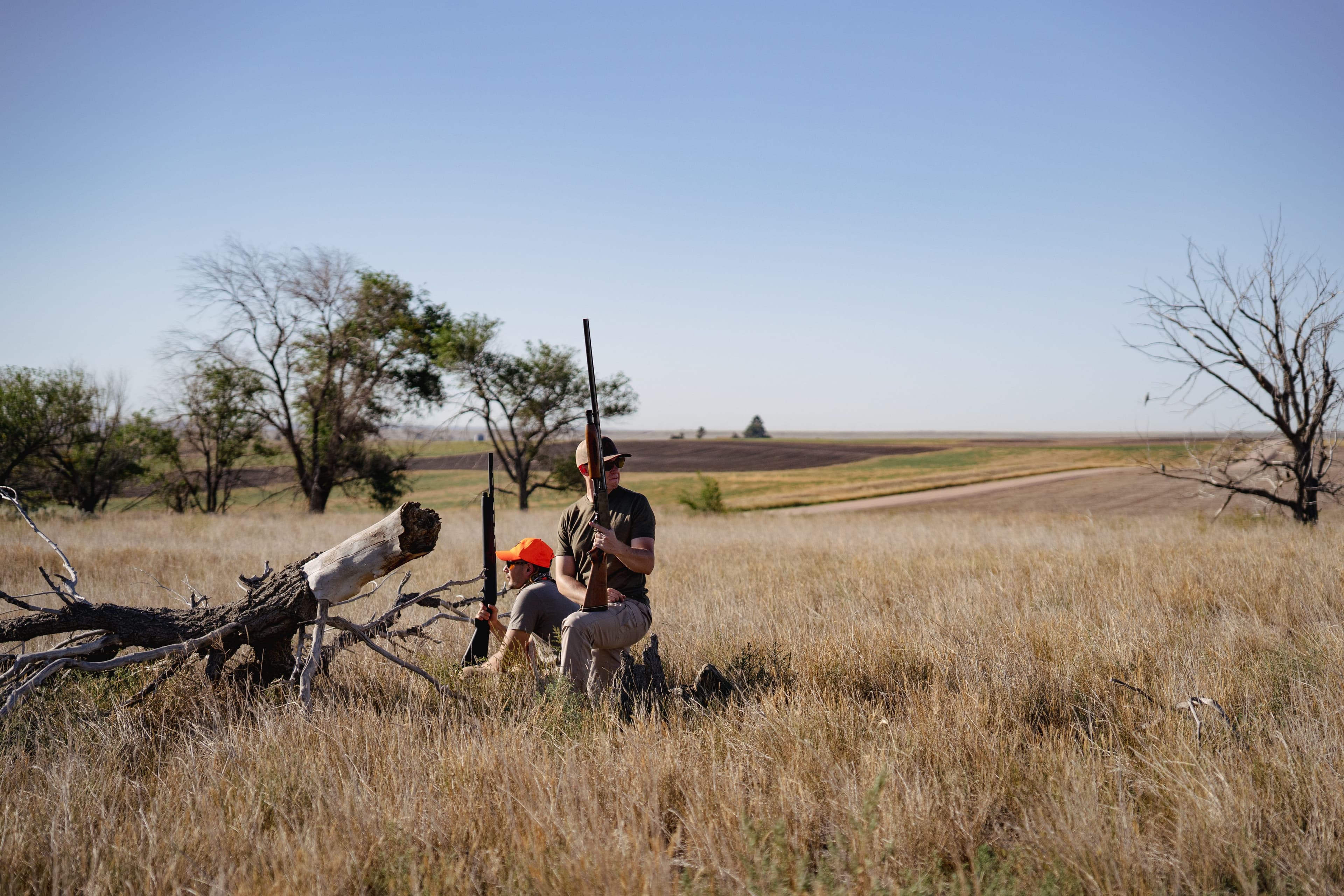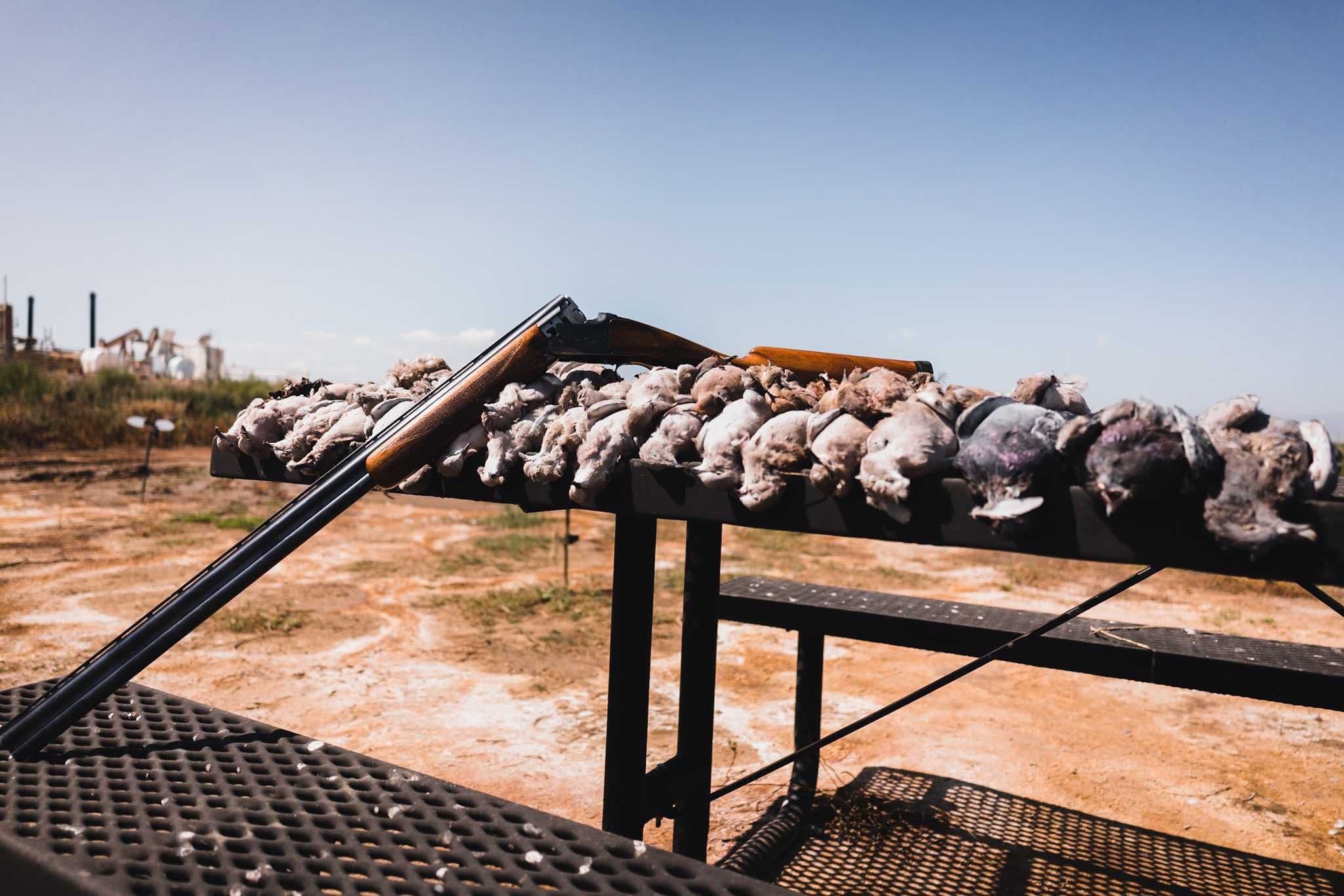Dove Hunting 101: The Best Beginner’s Guide with Some Advanced Tactics


Justin Hunold
08/09/2024
Dove hunting is a cherished tradition among hunters, offering an exciting challenge and a great way to improve your shooting skills. Whether you’re a seasoned hunter or a newcomer to the sport, understanding the basics of dove hunting is essential. This guide will walk you through everything you need to know to get started.

Understanding Dove Behavior
Doves are fast, agile flyers, making them a challenging target. They typically feed on grains and seeds, preferring open fields with abundant food. Knowing their habits and patterns will significantly increase your chances of success.
- Feeding Habits: Doves feed primarily on the ground, seeking seeds from plants like sunflowers, millet, and wheat. Their high metabolism means they need to eat frequently throughout the day. Understanding their feeding schedule can help you anticipate their movements.
- Flight Patterns: Doves are creatures of habit and often follow the same flight paths daily. They usually fly low to the ground and take the path of least resistance. Observing these patterns can give you valuable insights into where to position yourself for the best shots.
- Roosting Behavior: Doves roost in trees or dense foliage at night to stay safe from predators. Early morning hunts can be particularly productive as doves leave their roosts to feed.
Scouting Locations
Scout your hunting area ahead of time. Look for fields with harvested crops, mainly sunflowers, millet, and wheat. Water sources such as ponds and small lakes are also attractive to doves. Setting up near these spots can provide ample shooting opportunities.
Essential Dove Hunting Gear
Having the right gear is crucial for a successful dove hunt. Here’s a rundown of the must-haves:
Shotguns
The choice of shotgun can make a big difference. The most common gauges for dove hunting are 12 and 20 gauge, both offering a good balance of power and ease of use. Here are some top picks:
- 12 Gauge: Offers a broader shot pattern and is more versatile.
- 20 Gauge: Lighter and easier to handle, especially for younger or smaller hunters.
Ammunition
Selecting the right shot size is critical to ensuring clean, ethical kills. The preferred shot sizes for doves are #7.5, #8, and #9. These sizes provide a dense pattern for hitting these tiny, fast-moving birds.
Clothing and Accessories
- Camo Clothing: Wear camouflage to blend into your surroundings. Lightweight, breathable fabrics are best for the warm early-season hunts. Ensure your clothing matches the environment where you’ll be hunting, whether it’s a field or a wooded area.
- Shooting Glasses: These glasses protect your eyes and enhance your vision. Yellow or orange-tinted lenses can improve contrast and make doves easier to spot against the sky.
- Ear Protection: Protect your hearing from repeated shotgun blasts. Options include foam earplugs or electronic earmuffs that amplify quiet sounds while blocking loud noises.
- Game Vest or Dove Belt: These pieces of kit help you carry your gear and provide easy access to ammunition. Look for vests with plenty of shell pockets and a large game pouch for holding birds.
- Boots: Comfortable, durable boots are essential for walking through fields and uneven terrain. Waterproof boots can be handy if you’re hunting near water sources.
Best Chokes for Dove Hunting
The choke you use in your shotgun can significantly impact your success. Here are the best options for dove hunting:
Improved Cylinder
The improved cylinder choke is a popular choice for dove hunting. It provides a broader shot pattern, ideal for hitting fast-flying birds at close to medium ranges.
Modified Choke
A modified choke can be a better option if you’re hunting in an area where shots are likely to be a bit longer. It offers a tighter pattern, increasing your chances of hitting doves at greater distances.
Advanced Dove Hunting Tactics
Once you’ve got the basics down, it’s time to refine your approach with some advanced tactics.
Decoy Placement
Using decoys can attract doves to your hunting spot. Place them in a natural-looking area spread on the ground near trees or fence lines. Motion decoys can add realism and increase their effectiveness. A typical setup includes a few decoys on the ground, with some placed on elevated perches to simulate feeding and resting birds.
Understanding Flight Patterns
Pay attention to doves' flight patterns in your hunting area. They often follow the same routes to and from feeding and watering areas. Position yourself along these flight paths to maximize your shooting opportunities. Setting up near natural funnels, such as gaps in tree lines or along fence rows, can increase your chances of intercepting birds.
Hunting in Pairs or Groups
Hunting with a partner or in a small group can increase your chances of success. Coordinate your shots to cover more area and reduce the chances of missing birds. Remember to maintain safe shooting zones to avoid accidents. Communication is vital—agree on who will cover which areas and take turns shooting to prevent confusion.

Using a Retriever
A good retriever dog can be invaluable in dove hunting. They can quickly and efficiently retrieve downed birds, saving time and effort. Training your dog to sit quietly and mark fallen birds will improve your overall hunting experience. Labradors and spaniels are popular choices for their natural retrieving instincts and trainability.
Timing Your Shots
Doves are small and fast, so timing your shots is crucial. Wait until the bird is within range and in a clear shooting lane before pulling the trigger. Practice leading your shots, aiming slightly ahead of the bird to account for its speed and direction.
Preparing for Dove Hunting: Shooting Exercises, Extra Gear, and Scouting Tips
Preparation is critical to a successful dove hunting season. Here’s how to get ready, from practicing your shooting to scouting the best fields and ensuring you have all the necessary gear.
Shooting Exercises and Practice
Doves are small, fast, and agile, making them challenging targets. Regular practice is essential to improving your accuracy and confidence in the field.
- Clay Pigeon Shooting: Simulating dove flight patterns with clay pigeons is an excellent way to practice. Focus on crossing shots and fast, erratic flight paths to mimic the real thing.
- Skeet Shooting: Skeet shooting courses provide a variety of angles and speeds that closely resemble dove hunting conditions. This practice helps improve your reaction time and aim.
- Gun Mounting Drills: Practice mounting your shotgun quickly and smoothly to your shoulder. This can be done at home using an unloaded gun. Consistent and correct gun mounting leads to better accuracy in the field.
Extra Gear to Take Along
Having the right extra equipment can make your hunt more enjoyable and successful, in addition to your basic hunting gear.
- Cooler: A cooler with ice packs to store your harvested doves and keep them fresh.
- Water and Snacks: Staying hydrated and energized is crucial, especially during long hunts in hot weather.
- Sunscreen and Insect Repellent: Protect yourself from sunburn and bug bites.
- First Aid Kit: Always have a basic kit for minor injuries.
- Binoculars: Binoculars are helpful for scouting and identifying doves at a distance.
- Chair or Stool: A portable chair or stool can make waiting for doves more comfortable.
Fields to Scout and Focus On
Scouting is a vital part of dove hunting preparation. Knowing where doves feed and fly will significantly improve your chances of a successful hunt.
- Agricultural Fields: Look for crops that attract doves, such as sunflowers, millet, wheat, and corn. Recently harvested fields are incredibly productive.
- Water Sources: Ponds, lakes, and stock tanks are important for doves, as they need water. Set up near these areas for good shooting opportunities.
- Flyways and Roosting Areas: Identify the flyways doves use between feeding and roosting sites. Setting up along these paths increases your chances of intercepting them.
Using Decoys and Blinds: Functional Setups for Success
Decoys and blinds can significantly enhance your dove hunting experience by attracting birds and providing better concealment.
Using Decoys
Decoys can make a significant difference in drawing doves into shooting range. Here’s how to use them effectively:
- Placement: Arrange decoys in natural-looking spreads. Place a few on the ground in a feeding posture and others on elevated perches like fences or low trees. This simulates a relaxed, feeding flock.
- Motion Decoys: To add movement and realism, use spinning-wing decoys or wind-activated models. Motion decoys are particularly effective at catching the attention of passing doves.
- Blend with the Environment: Ensure the decoys match the environment. Based on the field conditions, adjust the setup to look as natural as possible.
Using Blinds
Blinds provide concealment, allowing you to remain hidden while waiting for doves. Here are some tips for setting up a practical blind:
- Natural Cover: Utilize natural cover whenever possible. Set up near bushes, tall grass, or tree lines to blend into the surroundings.
- Portable Blinds: If natural cover is scarce, use portable blinds. Pop-up blinds or camouflage netting can be set up quickly and offer excellent concealment.
- Positioning: Place your blind where you have a clear view of the decoys and the anticipated flight path of the doves. Ensure you have a good shooting angle without obstructions.
- Comfort and Accessibility: Make sure your blind is comfortable and allows easy access to your gear. A comfortable hunter is a patient hunter, and patience is often rewarded in dove hunting.
Conclusion
Dove hunting is an exhilarating and rewarding pursuit that combines skill, strategy, and a love for the outdoors. Understanding dove behavior, equipping yourself with the right gear, and employing advanced tactics can enhance your success and enjoyment in the field. Whether you’re a novice or an experienced hunter, there’s always something new to learn and appreciate in dove hunting. Happy hunting!